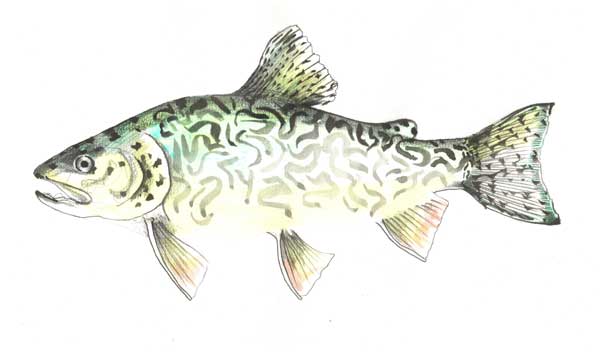
Tiger Trout (Salmo trutta X Salvelinus fontinalis)
Current record: 11lb 8oz
Water: Alderneuk Trout Fishery, Waterside Farm, Terregles
The tiger trout (Salmo trutta x Salvelinus fontinalis) is a unique hybrid species resulting from the crossbreeding of a brown trout (Salmo trutta) and a brook trout (Salvelinus fontinalis). This striking fish exhibits a combination of characteristics from both parent species, featuring the vibrant and intricate patterns of a brook trout and the streamlined body of a brown trout. The result is a visually captivating species with a distinctive appearance, marked by a background color ranging from olive to gold and dark, bold markings reminiscent of a tiger's stripes.
Tiger trout are known for their adaptability and have been introduced into various freshwater environments, including lakes, ponds, and streams. Anglers appreciate them for their aggressive feeding behavior and are often drawn to the challenge of catching these visually appealing fish. Due to their hybrid nature, tiger trout may exhibit different traits depending on the specific genetic makeup of the individual, adding an element of unpredictability to their appearance and behavior.
In terms of diet, tiger trout are opportunistic predators, feeding on a variety of aquatic insects, small fish, and crustaceans. This versatile diet contributes to their ability to thrive in diverse aquatic ecosystems. Anglers commonly target tiger trout using a variety of fishing techniques, including fly fishing, spinning, and bait fishing, depending on the fishing regulations of the specific location.
Conservation efforts related to tiger trout focus on sustainable stocking practices and habitat management. Like many trout species, they require clean and well-oxygenated water, making water quality management crucial for their survival. Additionally, careful consideration is given to stocking locations and ensuring that the introduction of tiger trout does not negatively impact native fish populations.
The popularity of tiger trout among anglers and the aesthetic appeal of these hybrids contribute to their significance in recreational fisheries. By understanding their biology, behavior, and habitat requirements, conservationists strive to strike a balance between the enjoyment of anglers and the preservation of healthy aquatic ecosystems.
Brown trout (Salmo trutta) and brook trout (Salvelinus fontinalis) are intergeneric hybrids that produce the tiger trout (Salmo trutta Salvelinus fontinalis). The name of the fish was derived from distinct vermiculations in its pattern, which reminded people of a tiger's stripes. Since the parent species of tiger trout are generally unrelated, belong to different families, and have different numbers of chromosomes, they are a rare anomaly in the wild. But with the help of specialised hatchery rearing methods, tiger trout may be reliably produced to suit the needs of stocking programmes.
Because brook trout eggs are typically too small for brown trout milt to successfully fertilise, tiger trout are only produced when brown trout eggs are fertilised with brook trout milt. Since the two parent species of tigers are from different genera within the Salmon family and have only a remote relationship, they are referred to as intergeneric hybrids. In actuality, brown trout and brook trout have different numbers of chromosomes—the latter has 80 and the former has 84. As a result, the majority of brown trout eggs that are fertilised by brook trout in the wild develop incorrectly and fail to produce any young.